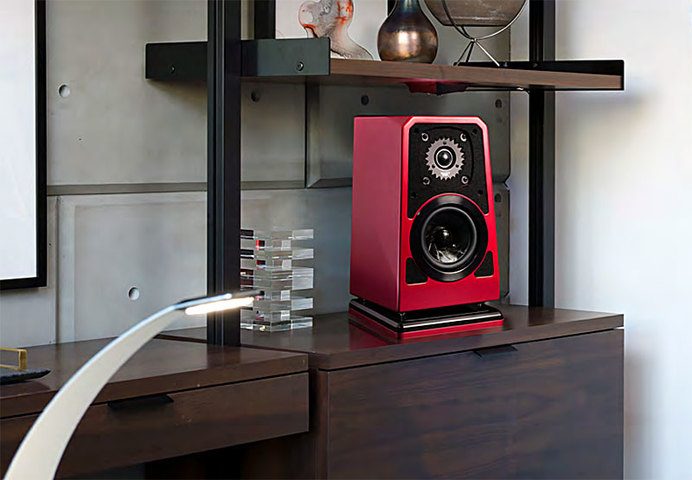
Provo, Utah | May 2018 | Wilson Audio Specialties
The Smallest Wilson
TuneTot® is the latest product from the Wilson Special Applications EngineeringTM team. While its name pays homage to the first WSAE product, it is a modern technical tour de force designed to offer the timbral beauty, dynamic nuance, soundstage resolution, and transparency — all the hallmarks of Wilson loudspeakers design culture — but do so in environments which are hostile to all of those qualities.
TuneTot is the smallest and least expensive Wilson, but it would be a mistake to see it as an “entry-level” offering. TuneTots are lovingly fab- ricated and assembled by the same group of talented craftsmen who build the WAMM Master Chronosonic, using exactly the same processes and techniques. Its cabinet and driver technology are derived directly from Alexx and Sabrina. Finally, each TuneTot that emerges from Wilson is held to the same rigorous, industry-leading manufacturing tolerances as its larger siblings, ensuring each TuneTot is as technically and musically accurate as the reference prototype. You hear precisely what Daryl Wilson heard in the final design.
From the inception of the first Wilson loudspeaker, it always has been understood that the time do- main is a critical factor—if musical authenticity is the goal. With TuneTot, the challenge was twofold: Isolating the active loudspeaker from its environment and providing adjustable correction in the time domain. Wilson’s engineers cleverly combined both needs into a single solution. TuneTot utilizes austenitic stainless-steel spike hardware that was designed specifically for TuneTot. The spike system also acts as a mechanical diode, draining unwanted energy out of TuneTot. One of the two pairs of spikes is fully adjustable in terms of length. The adjustable spikes are installed in either the front or the rear of the loudspeaker, depending on the installation height of TuneTot. The adjustability of the spikes changes the rake angle of TuneTot and accurately facilitates time-domain adjustability. Wilson provides precise a simple installation setup technique that allows TuneTot to be corrected in the time domain for each installation.

An Enclosure Only Wilson Could Design
Custom composites have several advantages over single-element materials, such as aluminum. Since composites are constructed from several different constituencies, each element can be uniquely optimized for a variety of design characteristics—such as acoustical damping and rigidity. Performance factors that are mutually exclusive in single-element materials can be individually addressed in composites. Just as is true for all Wilson’s, TuneTot’s enclosure was analyzed and reanalyzed using its state-of-the-art Laser Vibrometry system in order to optimize enclosure-wall thicknesses and the strategic implementation of the proprietary composites. With this precision instrument, WSAE engineers are able to readily detect even the tiniest en- closure vibrations—at the level of billionths of a meter. The process aides the engineers as in their search for the ideal combination and geometry of the composites for the cabinet. TuneTot is constructed from two Wilson proprietary composites—the proven combination of Wilson’s X- and S-material. Wilson’s engineers didn’t stop there. Perfectly rectangular enclosures are inexpensive and easy to build but suffer from music-destroying internal reflections generated by parallel walls. TuneTot’s enclosure is asymmetrical, ensuring no two internal surface is parallel. Inspired by technology from the Alexia Series 2 and the WAMM, TuneTot’s cabinet additionally features a complex internal reflection management system.

A New Special Application Ecosystem
TuneTot is but one element within an ecosystem populated with custom, a la carte tools and accessories (purchased separately) designed to maximize TuneTot’s performance and cosmetic beauty in a wide variety of applications.
Environmental music systems are increasingly part of contemporary lifestyles. The Wilson Audio Duette, successfully addressed the challenges caused by near boundary placement. TuneTot builds on that technology. It was designed specifically to be installed on counter tops, bookshelves, desktops and credenzas. In the past, placing a loudspeaker in these acoustically challenging locations has meant accepting serious sonic compromises. Interactions and resonances from the furniture or shelf on which the loudspeaker rests are a source of audible distortion and colorations—deleterious factors most loudspeaker designers simply accept. The Wilson WayTM demanded a new look at the problem. The Special Applications Engineering team spent several months researching the interactions between TuneTot and the surface upon which it is installed. It quickly became clear that assumptions surrounding environmental resonance control needed to be re-examined. For these installations, the challenges presented are very different from what exists for a typical floor-standing loudspeaker spiked to the floor— problems that require a different strategy. A series of accessories were developed specifically to address furniture-born resonances endemic to these types of installations. When a loudspeaker is installed on a wood desk or bookshelf, the challenges presented are very different from what exists for a typical floor-standing loudspeaker spiked to the floor—problems that require a different strategy.

When the TuneTot is mounted on a resonant surface, such as a wood desk or sideboard, the ISOBase is ideal. It is an interim platform which is placed between TuneTot and surface below. In this application, the ISOBase dramatically reduces spurious interaction and mechanical resonances generated by the loudspeaker. The ISOBase utilizes a sandwiched series of constrained layers constructed from Wilson’s proven pro- prietary composites and some newly developed polymers. In these types of installations, a polymer designed to provide optimal damping is the preferred material to interface with the resonant surface below. ISOBase offers unprecedented levels of decoupling and isolation between TuneTot and the structure upon which it rests. It is available in five different paint colors and four metal-hardware choices.
To Each Their Own
Color—expressed through the stunning palette of Wilson’s state-of-the-art WilsonGloss® paint—has long been a source of pride and personal expression among Wilson owners. Wilson has added five new WilsonGloss colors created specifically for TuneTot: Quartz, Ivory, Crimson, Carbon, and Teak. In addition to Black and Clear, Wilson has added two new anodized-color-finish options for TuneTot’s metal hardware. Many Wilson owners prefer to listen without the Grille attached. For these installations, Wilson designed the optional TuneTot Ring, which elegantly covers the mounting hardware securing the woofer. The TuneTot Ring is individually milled from 6061-T6 aluminum and is elegantly finished in a choice of four anodized colors. For those listeners who prefer a Grille, one is available for TuneTot. Each low-diffraction frame is milled from solid billets of ultra-low-resonance X-material composite. Acoustically transparent fabric (available in six colors) is meticulously hand stretched onto each composite frame. As a part of the TuneTot Ecosystem, Wilson is introducing five new paint colors and two new hardware anodized colors (for a total of four) specifically for TuneTot. Owners are able to custom configure their loudspeakers with just the right combination of perfor- mance options, paint color choice, and hardware and grille colors based on their individual aesthetic desire and installation needs. Not content with designing a simple “bookshelf ” loudspeaker, Wilson’s Special Applications Engineering team has, once again, redefined what is possible for these acoustically hostile installations.
Price (U.S. MSRP):
TuneTot—$9,800.00 (pair)
In Upgrade Colors—$10,500.00
ISOBase—$2,100.00 (pair)
TuneTot Ring—$649.00 (pair)
TuneTot Grille—$299.00 (pair)
Specifications
Enclosure Type Woofer: Rear Vented
Enclosure Type Tweeter: Sealed
Mid Woofer: 5.75 inches (14.61 cm) Doped Paper Pulp
Tweeter: 1 inch (2.54 cm) Doped Silk Fabric
Sensitivity: 86dB@1W@1m@1k
Nominal Impedance: 8 ohms / minimum 6.61 ohms @ 172 Hz
Minimum Amplifier Power: 25 Watts per channel
Frequency Response: 65 Hz—23 kHz +/- 3 dB Room Average Response [RAR]
Overall Dimensions: Height—14.83 inches (37.67 cm) w/o spikes
Width—8.61 inches (21.87 cm)
Depth—10.19 inches (25.88 cm)
System Weight Per Channel: 29 lbs (13.15 kg)
Total System Shipping Weight (approx.): 70 lbs (31.75 kg)





